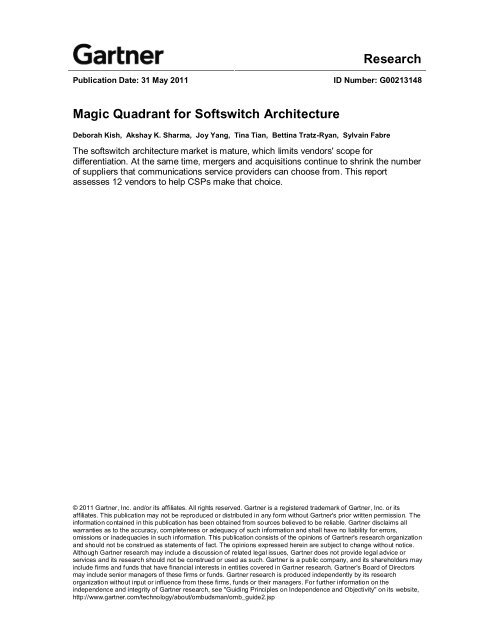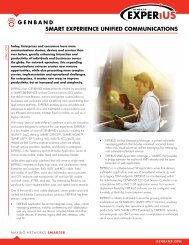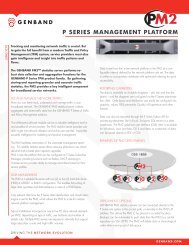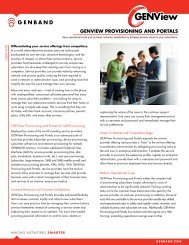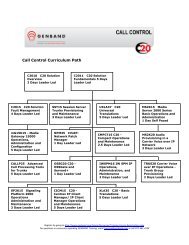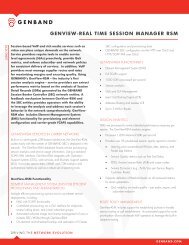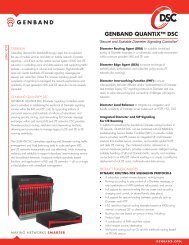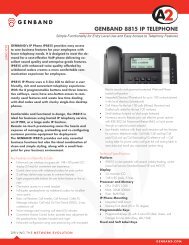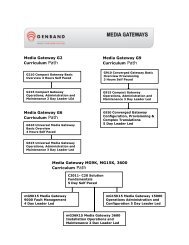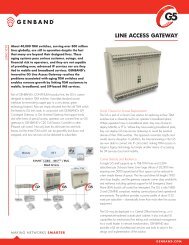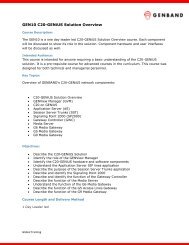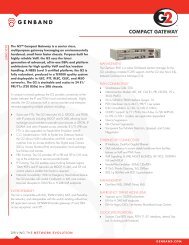Research Magic Quadrant for Softswitch Architecture - Genband
Research Magic Quadrant for Softswitch Architecture - Genband
Research Magic Quadrant for Softswitch Architecture - Genband
Create successful ePaper yourself
Turn your PDF publications into a flip-book with our unique Google optimized e-Paper software.
<strong>Research</strong><br />
Publication Date: 31 May 2011<br />
ID Number: G00213148<br />
<strong>Magic</strong> <strong>Quadrant</strong> <strong>for</strong> <strong>Softswitch</strong> <strong>Architecture</strong><br />
Deborah Kish, Akshay K. Sharma, Joy Yang, Tina Tian, Bettina Tratz-Ryan, Sylvain Fabre<br />
The softswitch architecture market is mature, which limits vendors' scope <strong>for</strong><br />
differentiation. At the same time, mergers and acquisitions continue to shrink the number<br />
of suppliers that communications service providers can choose from. This report<br />
assesses 12 vendors to help CSPs make that choice.<br />
© 2011 Gartner, Inc. and/or its affiliates. All rights reserved. Gartner is a registered trademark of Gartner, Inc. or its<br />
affiliates. This publication may not be reproduced or distributed in any <strong>for</strong>m without Gartner's prior written permission. The<br />
in<strong>for</strong>mation contained in this publication has been obtained from sources believed to be reliable. Gartner disclaims all<br />
warranties as to the accuracy, completeness or adequacy of such in<strong>for</strong>mation and shall have no liability <strong>for</strong> errors,<br />
omissions or inadequacies in such in<strong>for</strong>mation. This publication consists of the opinions of Gartner's research organization<br />
and should not be construed as statements of fact. The opinions expressed herein are subject to change without notice.<br />
Although Gartner research may include a discussion of related legal issues, Gartner does not provide legal advice or<br />
services and its research should not be construed or used as such. Gartner is a public company, and its shareholders may<br />
include firms and funds that have financial interests in entities covered in Gartner research. Gartner's Board of Directors<br />
may include senior managers of these firms or funds. Gartner research is produced independently by its research<br />
organization without input or influence from these firms, funds or their managers. For further in<strong>for</strong>mation on the<br />
independence and integrity of Gartner research, see "Guiding Principles on Independence and Objectivity" on its website,<br />
http://www.gartner.com/technology/about/ombudsman/omb_guide2.jsp
WHAT YOU NEED TO KNOW<br />
Communications service providers (CSPs) face significant competitive pressure and the<br />
challenge of differentiating themselves with enhanced services that reduce churn, while also<br />
cutting costs. In the right circumstances, network trans<strong>for</strong>mation, especially in the session control<br />
and service layer, can enable CSPs to offer such services in blended "life style" bundles,<br />
incorporating location-based and personalized services across different media and devices.<br />
An important step toward this trans<strong>for</strong>mation is to reduce operational expenditure (opex) by<br />
improving operational efficiency and streamlining network per<strong>for</strong>mance. This will enable CSPs to<br />
focus on the services, the application environment and the underlying network resources required<br />
to optimize delivery of new services.<br />
Across the globe, CSPs have been implementing Internet Protocol (IP) Multimedia Subsystem<br />
(IMS) technology as a core part of a network and service trans<strong>for</strong>mation road map that marries<br />
implementation of IMS to development of a service delivery plat<strong>for</strong>m (SDP) architecture based on<br />
service-oriented architecture. Their main aims with IMS are to support interoperability, quality of<br />
service (QoS), quality of experience (QoE), accurate billing and integration of new services. QoS<br />
and accurate billing support are important mainly because today's networks are based primarily<br />
on packet-switched IP protocols that support only "best ef<strong>for</strong>t" services. Most fixed and all mobile,<br />
voice and SMS networks are still circuit-switched, and mobile data networks lack QoS control<br />
features. There<strong>for</strong>e, most voice-over-IP (VoIP) applications cannot provide QoS guarantees to<br />
end users. Nor can they guarantee accurate billing <strong>for</strong> network providers. Hence an important<br />
objective of the IMS standard is to create an architecture <strong>for</strong> deploying IP voice applications that<br />
offer both QoS and accurate billing.<br />
CSPs' top priorities are to reduce capital expenditure (capex) and opex, increase revenue,<br />
improve the end-user experience, and meet the growing need to support IP-based services. With<br />
these aims comes a recognition of the risk associated with keeping time division multiplexing<br />
(TDM) equipment <strong>for</strong> much longer. As there is also a need to reduce energy costs <strong>for</strong> fixed and<br />
mobile switching centers and local exchanges, CSPs have started to test and compare the<br />
usage-based power consumption of servers, softswitch plat<strong>for</strong>ms and gateways. With increasing<br />
subscriber traffic, Advanced Telecommunications Computing <strong>Architecture</strong> (ATCA)-based<br />
switching solutions that offer increased flexibility, and server board interfaces that deliver<br />
increased per<strong>for</strong>mance at linear power consumption, are reducing CSPs' exposure to energy<br />
costs, including the amount of cooling required at facilities, and their technology footprints.<br />
Together with industry partners and research institutes, vendors such as Alcatel-Lucent (with Bell<br />
Labs), Italtel (with Cisco) and Nokia Siemens Networks (with Opera) are investing in the<br />
innovation of energy-efficient technology. For carrier customers this has an immediate impact on<br />
the technological and business justification <strong>for</strong> buying. It also improves the vendors' market<br />
positioning and branding as companies that focus on the strategic issues ahead.<br />
Investment by CSPs has shifted from softswitches, media gateways and signaling gateways to<br />
session border controllers (SBCs), voice application servers, and solutions relating to the<br />
Diameter protocol, policy and session management, and deep packet inspection (DPI) using IMS<br />
— all of which are tied to Long Term Evolution (LTE) technology and the expected increase in<br />
traffic that will also drive these market segments. SBCs are being deployed essentially to bypass<br />
the TDM network, and this in turn reduces the need to deploy media gateways, so the media<br />
gateway controller (a softswitch) will, in time, have nothing to control, particularly as service and<br />
control logic move away from the switch. Remaining growth in the softswitch segment derives<br />
mainly from the shift from fixed softswitches to mobile softswitches.<br />
Publication Date: 31 May 2011/ID Number: G00213148 Page 2 of 24<br />
© 2011 Gartner, Inc. and/or its Affiliates. All Rights Reserved.
MAGIC QUADRANT<br />
Figure 1. <strong>Magic</strong> <strong>Quadrant</strong> <strong>for</strong> <strong>Softswitch</strong> <strong>Architecture</strong><br />
Source: Gartner (May 2011)<br />
Market Overview<br />
A Slow but Steady Transition From TDM to IMS<br />
CSPs continue to alter their networks as they move to decommission legacy infrastructure,<br />
develop new technology and serve customers more effectively. They have been investing in nextgeneration<br />
equipment and architectures <strong>for</strong> over a decade in order to introduce VoIP technology<br />
and run networks more efficiently.<br />
The need <strong>for</strong> differentiation and new revenue streams has led to the development of new<br />
applications <strong>for</strong> which the use of softswitch architecture alone is not the best approach. This has<br />
increased the requirement <strong>for</strong> CSPs to invest in next-generation equipment. Most large CSPs are<br />
switching to IMS architecture.<br />
IMS is a standardized, open architecture, based on the Session Initiation Protocol (SIP). It defines<br />
how applications and services are delivered to customers, regardless of access network<br />
(including the public switched telephone network [PSTN]). The technology separates session<br />
control from the actual applications <strong>for</strong> maximum flexibility, and it standardizes the signaling and<br />
control layer, together with network-based and Web-enabled applications and services. It helps<br />
CSPs build a strategy based on the convergence of plat<strong>for</strong>ms, technological solutions and<br />
Publication Date: 31 May 2011/ID Number: G00213148 Page 3 of 24<br />
© 2011 Gartner, Inc. and/or its Affiliates. All Rights Reserved.
services, as well as of end-user devices and terminals, including handsets and client premises<br />
equipment.<br />
IMS and LTE<br />
Migrations are never completed quickly, and the measures adopted so far to remedy the<br />
immediate problems caused by an increase in data and multimedia traffic essentially amount to<br />
sticking plasters. In time, longer-lasting solutions will be needed, but CSPs could maintain their<br />
present approach <strong>for</strong> years be<strong>for</strong>e rolling out new services, <strong>for</strong> which much higher capacity is<br />
needed, only in select areas and on differing parts of the network.<br />
LTE is still in the early phase of adoption — as of January 2011 there had been only 17 launches<br />
of commercial LTE networks worldwide. To help CSPs switch to LTE, the Third Generation<br />
Partnership Project (3GPP) standards body has approved IMS as the official framework <strong>for</strong><br />
handling voice over LTE (VoLTE). As a result, LTE networks will need appropriate IMS<br />
infrastructure — including softswitches — to control, ensure QoS and charge correctly <strong>for</strong> voice<br />
services. We expect, however, that most CSPs launching LTE will focus on data services <strong>for</strong> the<br />
first couple of years.<br />
IMS architecture also allows CSPs to integrate services efficiently, so they can be bundled to<br />
meet the needs of end users. It eliminates the need <strong>for</strong> the traditional "stovepipe" approach in<br />
which all features are included in single applications that do not integrate easily with others. IMS<br />
makes it possible to draw on presence, location-based, push-to-talk and other services <strong>for</strong> new<br />
applications.<br />
The value of IMS as a complementary architecture to LTE lies in delivering basic voice services<br />
alongside complex converged or combinational applications. As a next-generation signaling and<br />
application delivery architecture, IMS provides the ability to offer blended services over a single<br />
control plane. Marketing <strong>for</strong> IMS focuses exclusively on next-generation applications and blended<br />
services such as presence, location, push-to-talk and gaming, together with multimedia video<br />
streaming and voice telephony. The VoLTE initiative of the Global System <strong>for</strong> Mobile<br />
Communications Association (GSMA) aims to devise a standard to enable mobile operators to<br />
provide traditional circuit-switched services, voice telephony and SMS using an LTE access<br />
network and a traditional GSM and Universal Mobile Telecommunications System (UMTS) core.<br />
Green IT<br />
As noted earlier, CSPs' top priorities include reducing capex and opex, increasing revenue and<br />
improving the end-user experience.<br />
To reduce energy costs <strong>for</strong> fixed and mobile switching centers and local exchanges, CSPs have<br />
started to test and compare the usage-based power consumption of servers, softswitch plat<strong>for</strong>ms<br />
and gateways. As subscriber traffic increases, more flexible ATCA-based switching solutions,<br />
together with server board interfaces that deliver increased per<strong>for</strong>mance at a constant level of<br />
power consumption, are reducing CSPs' energy costs, including the amount of cooling required<br />
<strong>for</strong> facilities, and technology footprints.<br />
Software is a key enabler of cloud-based services, and the model whereby CSPs offer software<br />
as a service (SaaS) will minimize their need <strong>for</strong> hardware. As a result, they will also be able<br />
innovate more easily, run networks more efficiently, launch new services and, in the long run,<br />
create new revenue streams.<br />
Less hardware means fewer truck rolls, less use of petrochemical resources — and there<strong>for</strong>e less<br />
pollution.<br />
Publication Date: 31 May 2011/ID Number: G00213148 Page 4 of 24<br />
© 2011 Gartner, Inc. and/or its Affiliates. All Rights Reserved.
For years, CSPs have been reducing opex by running more robust services on lower-cost<br />
plat<strong>for</strong>ms in parallel with legacy systems. However, the trend now is toward newer, more costeffective<br />
solutions and self-care (whereby CSPs manage networks entirely on their own,<br />
including, <strong>for</strong> example, software loads).<br />
Vendors with a strong "sustainability" pitch, and those that offer both ATCA and blade server<br />
approaches, should leverage their messaging around reductions in power consumption and<br />
software-based solutions linking them to cloud-based architectures.<br />
Market Trends<br />
Mobile Devices and Mobile Traffic Growth<br />
Use of mobile data services, from third-generation (3G) USB modems and smartphones, has<br />
risen substantially during the past few years. This is a development that requires CSPs to make<br />
decisions about their investment in infrastructure — the rise in mobile data traffic may distress the<br />
signaling network and require changes to cope with the increasing number of devices in use.<br />
Along with the boom in the amount of data traffic, the complexity of traffic has increased<br />
dramatically. Apple's App Store now offers approximately 300,000 applications, up from 800 in<br />
2008. Data traffic is now more complicated, compared with simple voice or plain SMS traffic on<br />
TDM networks, because sessions can be of any type — multimedia, voice or SMS, <strong>for</strong> example.<br />
Additionally, given the increased number of mobile services and applications expected during the<br />
next few years, including mobile video, social networking, commerce and location-based<br />
services, we expect complicated traffic environments <strong>for</strong> mobile communications as IMS<br />
becomes more widely deployed.<br />
CSPs must recognize that their technical abilities to shape traffic based on subscriber behavior<br />
patterns need to be paired with skilled marketing and good customer relations. Customers and<br />
regulators need to be educated about how CSPs plan to avoid violations of net-neutrality and<br />
privacy principles. Clear marketing and terms and conditions can go a long way to preventing<br />
problems here, but CSPs must still be careful not to block content or actively degrade network<br />
per<strong>for</strong>mance <strong>for</strong> particular services, and they must maintain subscribers' privacy.<br />
Vendors that focus on mobile operators and their needs <strong>for</strong> service differentiation and network<br />
optimization are well-placed to help CSPs in their transition to LTE. Ericsson and Huawei are<br />
particularly strong in this respect, while Nokia Siemens Networks and Alcatel-Lucent are working<br />
to succeed in these markets. However, to execute on its vision <strong>for</strong> technological requirements,<br />
Nokia Siemens Networks must improve its financial position, link its technological innovation to<br />
professional services, and increase its marketing in relation to the shift from hardware to<br />
software.<br />
RCS, IMS, LTE and the Threat From Over-the-Top Providers<br />
The Rich Communication Suite (RCS) Initiative continues to develop with respect to broadband<br />
access, content sharing, enhancements to sharing and presence, and geolocation in<strong>for</strong>mation.<br />
However, it has still not "gone live." If RCS continues to be delayed, CSPs and over-the-top<br />
(OTT) providers may develop their own applications in search of differentiation. Indeed, an RCSlike<br />
service has already been launched in South Korea, and aggressive moves against RCS from<br />
OTT players, such as Google, have accelerated.<br />
RCS services bring together a number of different functions in a single place on a consumer<br />
device. The Apple iPhone's address book is an early example of part of the RCS's intelligent<br />
address book functionality. It has been followed by Android-based phones that enable the user to<br />
start an e-mail, see an address in Google maps, and click on any telephone number to make a<br />
Publication Date: 31 May 2011/ID Number: G00213148 Page 5 of 24<br />
© 2011 Gartner, Inc. and/or its Affiliates. All Rights Reserved.
call or send a text message — features not currently part of RCS. Future releases of RCS are<br />
likely to include functions that let customers initiate more types of communication session from<br />
the address book (chat, instant messaging, e-mail and text or voice, as well as file and video<br />
sharing), see the "presence" state and status updates of contacts, view any content their contacts<br />
choose to expose, and see aggregate in<strong>for</strong>mation within their address book about what contacts<br />
have been doing across multiple social networks.<br />
The GSMA's RCS Initiative aims to produce specifications <strong>for</strong> use by vendors, handset<br />
manufacturers and network operators. These specifications will cover the core features and<br />
implementation guidelines <strong>for</strong> interoperability across operators in any given geography, <strong>for</strong><br />
features such as presence and video calling, regardless of the client device or network<br />
architecture used.<br />
RCS services use IMS to handle underlying network features, such as authentication and<br />
charging <strong>for</strong> services. RCS defines the key interoperability requirements between IMS features,<br />
including presence, location-based services, and personalized connections between network and<br />
users. IMS has been hyped <strong>for</strong> the past five years but has only recently been found useful, thanks<br />
to RCS. IMS will serve as a complementary architecture <strong>for</strong> LTE networks.<br />
To date, over 100 CSPs, vendors, handset manufacturers and software developers have<br />
participated in the RCS Initiative. They have been developing applications and services that are<br />
extensions of SMS — <strong>for</strong> example, mobile video sharing — as well as deep packet inspection<br />
(DPI) and subscriber data management (SDM) solutions that can use gathered data <strong>for</strong> mobile<br />
advertising. SBC vendors such as Acme Packet and <strong>Genband</strong> have been developing solutions<br />
involving DPI to protect and authenticate network traffic. Vendors such as Ericsson, Alcatel-<br />
Lucent, Nokia Siemens Networks and Huawei are developing SDM solutions to identify<br />
subscriber behavior and help CSPs turn collected data into revenue-generating opportunities. As<br />
subscriber adoption of RCS-type services gains momentum, CSPs could benefit from their<br />
collected data and work toward offering more advanced services.<br />
The RCS Initiative's objective is to provide a range of services, and it is acting as a catalyst <strong>for</strong><br />
the rise of LTE, in which IMS is the long-term solution <strong>for</strong> enabling multimedia communications<br />
(as end-to-end IP-based services). After introducing RCS, CSPs can expect to deploy IMS<br />
infrastructure over 3G data access equipment within their wireless networks, which will enable an<br />
easy migration to LTE. Currently, LTE is a "data play" — most CSPs are migrating to LTE but will<br />
continue to run their voice services on existing 2G or 3G networks. IMS, however, can be used as<br />
a complementary architecture to provide voice services.<br />
Benefits that will encourage trials and deployments of RCS by CSPs include the ability <strong>for</strong> users<br />
to see the status of friends. This could trigger communication sessions that would not otherwise<br />
occur. It may also encourage them to use what are currently somewhat niche functions, such as<br />
video telephony. Thanks to the many functions available, consumers will likely increase their<br />
general use of mobile data and voice services, and thereby increase CSPs' average revenue per<br />
unit and perhaps "subscriber stickiness." Enterprise users may find even more benefits from<br />
using RCS services. There<strong>for</strong>e vendors, while participating in the RCS Initiative, are developing<br />
packaged software suites around RCS services and capabilities.<br />
Vendor Environment<br />
Consolidation Continues<br />
Over the years, the number of competitors in this market has shrunk due to mergers and<br />
acquisitions, vendors ceasing operations and, from the perspective of Gartner's <strong>Magic</strong><br />
<strong>Quadrant</strong>s, vendors not meeting the inclusion criteria.<br />
Publication Date: 31 May 2011/ID Number: G00213148 Page 6 of 24<br />
© 2011 Gartner, Inc. and/or its Affiliates. All Rights Reserved.
On 28 May 2010, Nortel completed the sale of its Carrier VoIP and Application Solutions (CVAS)<br />
business to <strong>Genband</strong>. As a result, <strong>Genband</strong> now owns softswitch products that focus on VoIP in<br />
wireline environments and media gateway products that focus on both wireline and wireless<br />
environments. We will assess <strong>Genband</strong>'s progress in incorporating the CVAS portfolio, and its<br />
marketing and associated sales and aftermarket capabilities, later in 2011.<br />
In addition, <strong>Genband</strong> has acquired Cedar Point Communications, a vendor best known in the<br />
cable operator environment.<br />
Nortel also sold its mobile softswitch product to Ericsson, along with its GSM business.<br />
In 2010, Veraz Networks, a softswitch and media gateway vendor, was acquired by Dialogic, a<br />
vendor that had focused on multimedia server software <strong>for</strong> video, voice, conferencing and fax<br />
services.<br />
Vendor Positioning<br />
With the economy still recovering, few vendors increased their revenue and market share in the<br />
softswitch and media gateway market in 2010. However, they kept their focus, pursued their road<br />
maps and strove to execute on their vision. Changes to product strategies, technological<br />
milestones, road maps, migration plans, and customer and industry "mind share" mean that their<br />
positions <strong>for</strong> Completeness of Vision and Ability to Execute have improved.<br />
Vendors that focused on mobile softswitches, particularly in emerging markets, executed well,<br />
especially when combining technology and managed services. Vendors with upgradable mobile<br />
infrastructure, the ability to help with migration paths to LTE, strong IMS portfolios with proven<br />
track records, and the voice technology that goes with LTE buildouts, were at a competitive<br />
advantage. Ericsson and Huawei maintain leadership positions in this <strong>Magic</strong> <strong>Quadrant</strong> partly on<br />
this basis and partly thanks to improved financial positions. <strong>Genband</strong> has joined Ericsson and<br />
Huawei in the Leaders quadrant. Although <strong>Genband</strong>'s financial per<strong>for</strong>mance is not as strong as<br />
the other Leaders, <strong>Genband</strong> has extended its geographical coverage and executed well on its<br />
road maps <strong>for</strong> the products acquired from Nortel. It also has a well-received end-to-end product<br />
portfolio.<br />
Vendors that focused on their core competency, chose complementary paths to innovation — by,<br />
<strong>for</strong> example, catering to cable and alternative carriers — and developed strategic partnerships<br />
and reseller agreements, maintained their positions by executing on their vision. Their success<br />
was partly due to the realization that CSPs are delaying comprehensive PSTN replacement<br />
projects and instead focusing on targeted voice network modifications that include LTE and some<br />
IMS-based service enablers. Gartner's research indicates that deployment of mobile softswitches<br />
will continue to grow, based on footprint extensions. Mobile softswitch deployments will continue<br />
to soar, especially <strong>for</strong> CSPs building mobile infrastructure in emerging markets according to<br />
GSM/3G/High-Speed Packet Access (HSPA) road maps or with WiMAX 802.16e-2005 in mind.<br />
Vendors that successfully support mobile network rollouts also offer their customers the ability to<br />
integrate and manage mobile networks efficiently. (We measure these vendors by their ability to<br />
meet CSP requirements specific to emerging markets or a particular subscriber or business<br />
segment.) Such vendors include Metaswitch Networks and Sonus Networks.<br />
Vendors without a strong position in mobile softswitching but with a solid understanding of their<br />
customer needs, as well as a solid technology innovation base <strong>for</strong> converged networks, have<br />
good vision. These vendors also combine their technology with capabilities in managed services,<br />
consulting, cloud strategies and hypervisor-based virtualization. They include Alcatel-Lucent,<br />
Italtel, Nokia Siemens Networks and ZTE.<br />
Publication Date: 31 May 2011/ID Number: G00213148 Page 7 of 24<br />
© 2011 Gartner, Inc. and/or its Affiliates. All Rights Reserved.
CSPs continue to invest in multivendor solutions, but the number of global vendors has fallen. In<br />
turn, the ecosystems built by vendors have created more flexibility and more options. The general<br />
approach to system integration and network design is to use one main vendor and to cherry pick<br />
best-of-breed solutions.<br />
Market Definition/Description<br />
The softswitch architecture market comprises softswitch/call control technology and VoIP media<br />
gateways. We expect that, <strong>for</strong> the next 12 to 18 months, most growth in this market will stem from<br />
deployments in the mobile environment, and from fixed and converged CSPs in emerging<br />
markets. Deployments of VoIP services delivered via IMS using the Call Session Control Function<br />
(CSCF) have been increasing, and we expect CSCF to be deployed more widely through 2015.<br />
CSCF deployments are likely to exceed IMS-capable deployments in 2012 (see "Forecast:<br />
Carrier Network Infrastructure, Worldwide, 2007-2015, 1Q11 Update").<br />
In softswitch architecture the underlying hardware is decoupled from call control, subscriber logic<br />
and service creation. A softswitch accesses, enables and applies applications according to<br />
predetermined profiles <strong>for</strong> individual subscribers. An application programming interface <strong>for</strong>ms the<br />
link between the call control layer and the application layer, and may be supported by an SDP<br />
architecture. Application servers and solutions focused on next-generation SDPs are not<br />
considered in this <strong>Magic</strong> <strong>Quadrant</strong>, so vendors of these products — such as BroadSoft,<br />
Accenture, Wipro, Oracle and HP — do not appear in it.<br />
Inclusion and Exclusion Criteria<br />
To appear in this <strong>Magic</strong> <strong>Quadrant</strong>, vendors of softswitch architecture had to have at least six<br />
reference customers in 2010 and to have generated at least $40 million in revenue from this<br />
market in the same year.<br />
Added<br />
<strong>Genband</strong> and Dialogic.<br />
Dropped<br />
Cedar Point Communications and Nortel have been dropped due to their acquisition by <strong>Genband</strong>.<br />
Veraz Networks has been dropped due to its acquisition by Dialogic.<br />
Evaluation Criteria<br />
Ability to Execute<br />
Product/Service. This refers to core goods and services offered by technology providers that<br />
compete in the defined market. It includes current product and service capabilities, quality,<br />
feature sets, skills and so on, whether offered natively or through OEM agreements and<br />
partnerships. Specifically, it includes the development of ecosystems to support specific CSP<br />
requirements, such as IP Centrex, as well as system integration and distribution, and after-sales<br />
support in different regions (where applicable). Support <strong>for</strong> third-party, non- SIP-based<br />
applications is critical, as are subscriber databases, profile servers and home subscriber servers.<br />
We also evaluate the consistent delivery of QoS, QoE and policy-based functions. Also important<br />
is the availability of comprehensive system integration services.<br />
Overall Viability (Business Unit, Financial, Strategy and Organization). Viability includes an<br />
assessment of the overall organization's financial health, the financial and practical success of<br />
Publication Date: 31 May 2011/ID Number: G00213148 Page 8 of 24<br />
© 2011 Gartner, Inc. and/or its Affiliates. All Rights Reserved.
the business unit, and the likelihood that the business unit will continue to invest in the product,<br />
offer the product, and advance the state of the art within the organization's portfolio of products.<br />
Included is an assessment of financial prudence and the value of the acquisition of companies<br />
delivering, <strong>for</strong> example, applications or SBCs.<br />
Marketing Execution. The clarity, quality, creativity and efficacy of programs designed to deliver<br />
the organization's message to influence the market, promote the brand and the business,<br />
increase awareness of the products, and establish a positive identification with the products,<br />
brand and organization in the minds of buyers. This "mind share" can be driven by a combination<br />
of publicity, promotional, thought leadership, word-of-mouth and sales activities. Also, the<br />
availability of case studies and the support of carrier customers improves a vendor's messages<br />
<strong>for</strong> the Class 4 or Class 5 switching market. Since the softswitch architecture market is diverse in<br />
terms of topology and affiliated migration to session control in IMS, we consider the different<br />
market shares and mind shares based on equipment deployments, as well as regional credibility<br />
among CSPs.<br />
Operations. The organization's ability to meet its goals and commitments. Factors include the<br />
quality of the organizational structure and the frequency of reorganization, including skills,<br />
experiences, programs, systems and other vehicles that enable the organization to operate<br />
effectively and efficiently on an ongoing basis. We also consider the transparency of synergies<br />
between marketing, services and R&D departments.<br />
Table 1. Ability to Execute Evaluation Criteria<br />
Evaluation Criteria<br />
Product/Service<br />
Overall Viability (Business Unit, Financial, Strategy,<br />
Organization)<br />
Sales Execution/Pricing<br />
Market Responsiveness and Track Record<br />
Marketing Execution<br />
Customer Experience<br />
Operations<br />
Source: Gartner (May 2011)<br />
Weighting<br />
standard<br />
high<br />
no rating<br />
no rating<br />
standard<br />
no rating<br />
standard<br />
Completeness of Vision<br />
Market Understanding. A technology provider's ability to understand buyers' needs and to<br />
translate that understanding into products and services. Vendors with the most vision listen to<br />
and understand buyers' wants and needs, and can shape or enhance them with their vision. This<br />
criterion covers:<br />
Understanding of CSPs' requirements <strong>for</strong> network convergence from TDM to IP, or voice<br />
over broadband and true VoIP.<br />
Mobile softswitch deployments from Release 4 onward in mobile capacity extension and<br />
network rollouts.<br />
The balance between short-term switch-based enhancements and full PSTN<br />
replacements to overcome capex constraints due to the economic downturn.<br />
Publication Date: 31 May 2011/ID Number: G00213148 Page 9 of 24<br />
© 2011 Gartner, Inc. and/or its Affiliates. All Rights Reserved.
Offers of professional consulting as well as systems and solutions integration to support<br />
complex technology migration to IP and SIP.<br />
Activities in standards bodies and various initiatives such as "plugfests" and the RCS<br />
Initiative.<br />
For vendors with wireless and wireline softswitching portfolios, targeting of IMS in their<br />
road maps.<br />
Marketing Strategy. A clear, differentiated set of messages consistently communicated<br />
throughout the organization and externalized through a website, advertising, customer programs,<br />
case studies and positioning statements. This criterion includes participation in industry education<br />
through webcasts and conference presentations. Also considered is participation in service and<br />
application development activities in the industry, and leadership of those ef<strong>for</strong>ts.<br />
Offering (Product) Strategy. A technology provider's approach to product development and<br />
delivery that emphasizes differentiation, functionality, methodology and feature set as they map to<br />
current and future requirements. This criterion covers:<br />
Physical footprint and network management features.<br />
IMS and next-generation SIP capabilities and migration, where appropriate.<br />
Partnerships and ecosystems.<br />
Configurations to meet regional or country requirements — <strong>for</strong> example, interfaces,<br />
power consumption, heating, air-conditioning, regulatory compliance and equipment<br />
measurements.<br />
Support <strong>for</strong> product road maps <strong>for</strong> IMS session control, and application enablers <strong>for</strong><br />
third-party and Web interfaces.<br />
Support <strong>for</strong> 3GPP/3GPP2 and Telecoms and Internet converged Services and Protocols<br />
<strong>for</strong> Advanced Networking (TISPAN) releases, as well as Data-Over-Cable Service<br />
Interface Specification (DOCSIS) 3.0.<br />
Support <strong>for</strong> professional services, such as consulting and system integration.<br />
Support <strong>for</strong> legacy migration.<br />
Ease of upgrading to IMS.<br />
Energy-efficiency and compliance with local recycling and materials mandates.<br />
Ability to offer software delivery models that meet customers' needs and eliminate "pain<br />
points" — <strong>for</strong> example, SaaS.<br />
Innovation. Direct, related, complementary and synergistic layouts of resources, expertise or<br />
capital <strong>for</strong> investment, consolidation, defensive or pre-emptive purposes. This criterion includes:<br />
The ability to commit to the special needs of individual CSPs' network rollouts, where<br />
economically feasible.<br />
Achievement of milestones in product development and compliance with the company's<br />
own road maps.<br />
A migration path <strong>for</strong> existing softswitch technology, to include new interfaces such as<br />
SIP and IMS control functions.<br />
Publication Date: 31 May 2011/ID Number: G00213148 Page 10 of 24<br />
© 2011 Gartner, Inc. and/or its Affiliates. All Rights Reserved.
Support <strong>for</strong> emerging applications in conjunction with fixed-mobile convergence and<br />
IMS.<br />
Support <strong>for</strong> test labs and test profiles.<br />
A road map and support <strong>for</strong> ATCA, as opposed to an approach based on proprietary<br />
servers.<br />
Support <strong>for</strong> ecosystem partners via interfaces and interoperability.<br />
Ability to offer software delivery models that meet customers' needs and eliminate pain<br />
points — <strong>for</strong> example, SaaS.<br />
Demonstration of appropriate budget <strong>for</strong> R&D planning.<br />
Table 2. Completeness of Vision Evaluation Criteria<br />
Evaluation Criteria<br />
Market Understanding<br />
Marketing Strategy<br />
Sales Strategy<br />
Offering (Product) Strategy<br />
Business Model<br />
Vertical/Industry Strategy<br />
Innovation<br />
Geographic Strategy<br />
Source: Gartner (May 2011)<br />
Leaders<br />
Weighting<br />
low<br />
standard<br />
no rating<br />
standard<br />
no rating<br />
no rating<br />
high<br />
no rating<br />
Leaders are high-viability vendors with a broad portfolio, significant market share, broad<br />
geographic coverage, a clear vision <strong>for</strong> how CSPs' needs will evolve, and a proven track record<br />
of delivering products. Their product portfolios are well-positioned and they are likely to continue<br />
to deliver leading products. Leaders do not necessarily offer the best solution <strong>for</strong> every customer<br />
requirement, however, and not all their products may be best of breed. Overall, though, they<br />
provide solutions that offer relatively low risk and high quality.<br />
The vendors in this quadrant, in alphabetical order, are Ericsson, <strong>Genband</strong> and Huawei.<br />
Challengers<br />
Challengers are vendors with strong market capabilities and good solutions <strong>for</strong> specific markets.<br />
They per<strong>for</strong>m well in terms of specific voice-over-broadband or regional requirements. However,<br />
they may lack vision <strong>for</strong> end-to-end VoIP network deployment (including voice service offerings<br />
<strong>for</strong> enterprise, small and midsize business, and residential markets), and <strong>for</strong> pricing, support and<br />
network migration.<br />
The vendors in this quadrant, in alphabetical order, are Metaswitch Networks and Sonus<br />
Networks.<br />
Publication Date: 31 May 2011/ID Number: G00213148 Page 11 of 24<br />
© 2011 Gartner, Inc. and/or its Affiliates. All Rights Reserved.
Visionaries<br />
Visionaries demonstrate a clear understanding of the VoIP market. They provide softswitch<br />
solutions in conjunction with media gateways, and professional services and network outsourcing<br />
capabilities. They have clear technology and market road maps, and they align their R&D<br />
budgets to the needs of their target markets. However, they either lack the ability to influence a<br />
large portion of the market, having not yet expanded their sales and support capabilities<br />
worldwide, or do not yet have the funding to execute with the same capabilities as the Leaders.<br />
The vendors in this quadrant, in alphabetical order, are Alcatel-Lucent, Italtel, Nokia Siemens<br />
Networks and ZTE.<br />
Niche Players<br />
Niche Players offer products that focus on a particular segment of the market or on a subset of<br />
functionality. Customers aligned with the focus of a Niche Player may find its offerings to be "best<br />
of breed" or at least a "good fit."<br />
The vendors in this quadrant, in alphabetical order, are Cisco, Dialogic and Technicolor/Cirpack.<br />
Vendor Strengths and Cautions<br />
Alcatel-Lucent<br />
Strengths<br />
Alcatel-Lucent has a comprehensive portfolio of IMS products that can be positioned <strong>for</strong><br />
softswitch and media gateway opportunities. The company has adopted an "IMS first"<br />
strategy, so that CSPs can move beyond voice to blended applications. Its softswitch<br />
and media gateway product line has been consolidated into a single unit, largely<br />
developed on standardized ATCA plat<strong>for</strong>ms, that can be flexibly deployed and<br />
reconfigured upon changes to the network architecture.<br />
As of 4Q10, Alcatel-Lucent had announced 70 IMS wins, 17 of these in 2010, including<br />
deals with China Telecom, China Unicom, China Mobile and VNT/VNPT. Alcatel-Lucent<br />
has secured one deal <strong>for</strong> commercial deployment of its VoLTE technology, and has<br />
several ongoing VoLTE trials. It held the first demonstration of VoLTE using an LTE<br />
handset at the Mobile World Congress in 2010. In addition, Alcatel-Lucent demonstrated<br />
LTE-enabled video communications services with Verizon Wireless at CES 2011. Mobile<br />
operator Vodafone Qatar has selected Alcatel-Lucent to deliver a fully converged<br />
network.<br />
Alcatel-Lucent has revamped its ef<strong>for</strong>ts to penetrate the growing mobile services market<br />
by updating its packet core solution, which uses the company's softswitch technology,<br />
and it has been selected <strong>for</strong> some high-profile reference cases, such as Verizon<br />
Wireless's LTE network. Also, Alcatel-Lucent has incorporated into its marketing<br />
messages the High Leverage Network and Application Enablement initiatives, of which<br />
IMS is a key component.<br />
Alcatel-Lucent's Bell Labs has announced an initiative relating to environmental issues.<br />
Green Touch comes at a time when vendors need to innovate, with environmental<br />
design in mind, in order to obtain technology with quicker time-to-market (due to faster<br />
prototype- and product-manufacturing cycles).<br />
Publication Date: 31 May 2011/ID Number: G00213148 Page 12 of 24<br />
© 2011 Gartner, Inc. and/or its Affiliates. All Rights Reserved.
Cautions<br />
Cisco<br />
Strengths<br />
Cautions<br />
Alcatel-Lucent has embedded security solutions in the network core by adding a SIP<br />
firewall in a media gateway, employing Center <strong>for</strong> Internet Security (CIS) benchmark<br />
testing used to certify MySQL interfaces, and introducing other security features to the<br />
softswitch.<br />
Alcatel-Lucent's financial health remains a concern as the merged company has failed to<br />
be consistently profitable. It has, however, maintained its market share position<br />
worldwide and increased its market share in Asia/Pacific.<br />
Despite expanding its footprint among mobile service providers, Alcatel-Lucent still trails<br />
some of its toughest competitors (such as Ericsson and Huawei) in the high-growth<br />
mobile space. However, as Alcatel-Lucent has gained traction with LTE deals, it could<br />
leverage its strength with IMS <strong>for</strong> LTE — VoLTE being a key driver of IMS adoption —<br />
and there<strong>for</strong>e also improve its per<strong>for</strong>mance in the general softswitch sector.<br />
Cisco's integrated approach — with session border control to be included in its PGW<br />
2200 <strong>Softswitch</strong>, and integrated voice application server and media gateway<br />
functionality in its BTS 10200 <strong>Softswitch</strong> — is favored <strong>for</strong> smaller carrier deployments in<br />
targeted areas, and has proved more successful with cable providers.<br />
The PGW 2200 <strong>Softswitch</strong> has been deployed with several customer-requested features<br />
to support homologation requests, lawful interception and support <strong>for</strong> innovative TDM-to-<br />
VoIP migration strategies.<br />
Cisco's intelligent media gateway supports multiple protocols, including SIP, H.323 and<br />
Media Gateway Control Protocol (MGCP), as well as multiple applications, such as SIP<br />
trunking, call center interactive voice response applications, voice-over-broadband<br />
termination, international VoIP termination, SBC functionality and hosted IP telephony. It<br />
generally suits VoIP operators with distributed networks supporting many points of<br />
presence, as it enables capacity to be scaled as subscriber numbers increase. It can<br />
also function as an SBC.<br />
The integrated SBC functionality of Cisco's Unified Border Element (UBE) software can<br />
be coupled with the media gateway's capabilities to provide support <strong>for</strong> PSTN and IP<br />
trunking, enabling CSPs to switch from providing TDM to SIP trunking services. It also<br />
supports interworking between H.323 and SIP networks, as well as in-box transcoding<br />
capabilities.<br />
Cisco lacks global presence <strong>for</strong> softswitches and media gateways, and has been<br />
reducing its focus on this space. It is mainly present in the cable market.<br />
Cisco is in good financial health, but has not focused on acquisitions that complement its<br />
softswitch portfolio. Nor has it invested in significant R&D <strong>for</strong> softswitch products.<br />
Cisco has not signed any major deal <strong>for</strong> softswitch or media gateway technologies in the<br />
past two years.<br />
Publication Date: 31 May 2011/ID Number: G00213148 Page 13 of 24<br />
© 2011 Gartner, Inc. and/or its Affiliates. All Rights Reserved.
Dialogic<br />
Cisco lacks an IMS "story" <strong>for</strong> carrier environments. Rather, it is investing in areas that<br />
are more enterprise-focused, with unified communications as a service.<br />
Dialogic completed its acquisition of Veraz Networks in October 2010. Veraz appeared in the<br />
Challengers quadrant last year, but in the present version we place Dialogic in the Niche Players<br />
quadrant, partly because of a lack of in<strong>for</strong>mation about its product road map and partly because it<br />
needs to demonstrate significant proofs in terms of customer wins, geographic footprint, and<br />
increased revenue in this market segment as a combined company.<br />
Strengths<br />
Cautions<br />
Dialogic is widening its footprint in the market. It is focusing on international Tier 2 and<br />
Tier 3 carriers in both mature and emerging markets.<br />
Dialogic is broadening its ecosystem and gaining new contracts. For example, it has a<br />
partnership with LS Cable of South Korea to develop quadruple-play service solutions<br />
<strong>for</strong> CSPs in emerging markets, and a deal with Global Crossing in Latin America. It has<br />
also completed interoperability testing with BroadSoft <strong>for</strong> its Integrated Media Gateway<br />
product, which extends its business VoIP capabilities. Dialogic will continue to use its<br />
relationship with BroadSoft to extend its reach to Central and Latin America,<br />
Asia/Pacific, and Europe, the Middle East and Africa (EMEA).<br />
The merger has brought complementary technologies together. Dialogic's heritage of<br />
enabling applications <strong>for</strong> voice and video complements Veraz's voice and data session<br />
control, security and transport technologies, and the combination promises to maximize<br />
the multimedia capabilities of 3G and 4G networks. Work continues to integrate<br />
elements of Dialogic's gateway family with Veraz's switching solutions.<br />
The company has launched a new family of products, called BorderNet, that includes<br />
SBCs. There are also new products, including mobile backhaul bandwidth optimizers, in<br />
its I-Gate product line.<br />
Dialogic needs to improve its messaging and emphasize its capabilities in cloud<br />
computing and SBC technology. It must also increase awareness of its involvement in<br />
standards bodies, plugfests and interoperability testing.<br />
The company lacks presence in high-growth mobile markets and in Class 5 replacement<br />
opportunities, though it is working determinedly to extend its relationship with BroadSoft.<br />
As part of its strategy <strong>for</strong> Class 5 technology in 2011, Dialogic will focus on gateway,<br />
SBC and associated Class 4 requirements, and work with BroadSoft <strong>for</strong> Class 5<br />
applications.<br />
Dialogic lacks a mobile strategy and an end-to-end IMS offering. It has not secured IMS<br />
core contracts and lacks visibility in Tier 1 carrier environments. It is, however, working<br />
to change this through planned announcements relating to the IMS core and mobile<br />
backhaul in 2011.<br />
Publication Date: 31 May 2011/ID Number: G00213148 Page 14 of 24<br />
© 2011 Gartner, Inc. and/or its Affiliates. All Rights Reserved.
Ericsson<br />
Strengths<br />
Cautions<br />
<strong>Genband</strong><br />
Strengths<br />
Cautions<br />
Ericsson's acquisition of Nortel's GSM business included a mobile softswitch product.<br />
With this it has increased its penetration of North America.<br />
Ericsson has a large and strong professional services organization <strong>for</strong> telecom<br />
networks, with a global reach.<br />
Ericsson's strategy is based on establishing strong local competence as close to its<br />
customers as possible.<br />
Ericsson has the largest mobile switching center (MSC) server pooling and the first<br />
native-IP 10-Gigabit Ethernet mobile media gateway to enter full commercial service. A<br />
new software release <strong>for</strong> its MSC-S Blade Cluster offering enabled Ericsson's first<br />
commercial multimedia telephony service that adheres to TISPAN specifications.<br />
Ericsson is active in softswitch and IMS standards bodies such as the 3GPP and<br />
TISPAN, and very active in the Internet Engineering Task Force (IETF) and other<br />
relevant bodies. However, it has been less active in the RCS Initiative, which is gaining<br />
prevalence.<br />
Ericsson may face a long-term challenge as its strongest competitor, Huawei, gains<br />
scale, market share and mind share in the carrier infrastructure space, especially in<br />
EMEA and emerging markets. Ericsson will find it harder to maintain mind share and<br />
market share if the security concerns about Huawei in the U.S. are allayed.<br />
Following its acquisitions of Nortel's CVAS business and Cedar Point Communications,<br />
<strong>Genband</strong> has a complex and competitive switching portfolio, including a wireline<br />
softswitch. <strong>Genband</strong> has partnerships with Alcatel-Lucent (via Spatial Wireless) and with<br />
Kapsch <strong>for</strong> its mobile softswitch, which works with its G9 Converged Media Gateway.<br />
The acquisition of Cedar Point Communications gives <strong>Genband</strong> a solid presence in the<br />
cable market, and balances its capabilities in that it is no longer just a supplier <strong>for</strong> telcos.<br />
<strong>Genband</strong> has announced a new software plat<strong>for</strong>m, GENiUS, which will be hosted by an<br />
ATCA plat<strong>for</strong>m to provide the C20 and CS15 software products. In future, all product<br />
development will be based on the GENiUS plat<strong>for</strong>m.<br />
The company has expanded its professional services business and claims that this now<br />
represents 30% to 35% of its total revenue.<br />
Within a year of acquiring Nortel's CVAS portfolio, <strong>Genband</strong> acquired Cedar Point.<br />
Although we believe this to be a strategic move that will increase the company's<br />
penetration of the cable market, <strong>Genband</strong> might be perceived as not having managed its<br />
venture-capital dollars wisely by making this second acquisition be<strong>for</strong>e it had fully<br />
assimilated the first.<br />
Publication Date: 31 May 2011/ID Number: G00213148 Page 15 of 24<br />
© 2011 Gartner, Inc. and/or its Affiliates. All Rights Reserved.
Huawei<br />
Strengths<br />
Cautions<br />
<strong>Genband</strong> did not acquire mobile softswitch equipment as part of the Nortel acquisition,<br />
as this equipment was included in the sale of Nortel's North American GSM mobile<br />
business to Ericsson in EMEA and Kapsch in Taiwan. Acquiring Nortel's mobile<br />
softswitch equipment would have been more beneficial to <strong>Genband</strong>, as this would have<br />
helped it win business from mobile carriers and in more diverse geographical areas.<br />
However, <strong>Genband</strong> does now partner with Kapsch <strong>for</strong> its mobile softswitch, which works<br />
with the G9 Converged Media Gateway.<br />
<strong>Genband</strong> must show that it can execute and influence at a level appropriate to its new<br />
position in the market. It also needs to demonstrate significant proof of this by winning<br />
new customers in the softswitch market, not just by selling extra capacity or ports to<br />
existing Nortel customers.<br />
<strong>Genband</strong> lacks the visibility among CSP customers to be a managed service provider<br />
<strong>for</strong> networks or IT, compared with Ericsson, Nokia Siemens Networks and Alcatel-<br />
Lucent.<br />
Huawei achieved healthy growth overall in 2010, and became the second-largest<br />
supplier of CSP infrastructure. In the core network segment, it has been the largest<br />
supplier of softswitch and media gateways <strong>for</strong> four years in a row. The company has<br />
gained strong mind share and market positioning <strong>for</strong> the control layer of the core,<br />
especially in emerging markets, and has maintained its installed base.<br />
In 2010, Huawei announced the SingleCORE solution, which, it claims, supports all<br />
media and services with one control plat<strong>for</strong>m and differentiated blade components and<br />
software modules. This solution will protect most of the investments made by CSPs<br />
when migrating. For example, mobile softswitches can support the media gateway<br />
control function (MGCF), and MGCF interworking with IMS, with only a software<br />
upgrade; similarly, mobile softswitches can migrate to IMS with only a software update.<br />
Just over a year after the announcement, Huawei has already implemented the solution<br />
<strong>for</strong>, among others, China Telecom, Vodafone Italy, Netcom, Millicom, Telecom<br />
Argentina, M1 and MTN.<br />
Huawei has made substantial ef<strong>for</strong>ts not only to reduce the energy consumption of<br />
softswitch technology, but also to reduce embedded energy use through more efficient<br />
transportation and logistics, analysis of resources and raw materials, and changes to<br />
packaging.<br />
Huawei's ef<strong>for</strong>ts to establish and run Joint Innovation Centers with CSPs including<br />
Deutsche Telekom, Orange, Vodafone and Telefonica enhance its client relationships<br />
and understanding of CSPs' needs.<br />
Huawei's voice switch and control revenue fell slightly in 2010 and showed regional<br />
imbalances. The company still has limited presence in North America, the region that<br />
represents about 25% of the global market's revenue. Huawei needs more momentum<br />
in mature markets, which would demonstrate its capabilities in more advanced network<br />
environments.<br />
Publication Date: 31 May 2011/ID Number: G00213148 Page 16 of 24<br />
© 2011 Gartner, Inc. and/or its Affiliates. All Rights Reserved.
Italtel<br />
Strengths<br />
Cautions<br />
Huawei's core network products should further leverage its software and services<br />
product lines in order to deliver an integrated migration solution <strong>for</strong> CSPs and show itself<br />
to be a strategic partner <strong>for</strong> them.<br />
Italtel has a strong innovation road map toward open plat<strong>for</strong>m and computing technology<br />
<strong>for</strong> virtualization and energy efficiency. This includes a cloud topology <strong>for</strong> control layer<br />
architecture.<br />
Italtel has engaged with customers regarding their concerns about IP network security<br />
and privacy issues with next-generation core topologies. Results from this engagement<br />
include the development of a security gateway <strong>for</strong> the network-to-network interface.<br />
Italtel has been working on versatile multipath migration scenarios <strong>for</strong> voice and<br />
multimedia to open up networks running on VMware and ATCA plat<strong>for</strong>ms <strong>for</strong> efficient<br />
and remote upgrade capabilities.<br />
Italtel is diversifying its client base by attracting customers in the public sector and<br />
utilities sector that want to control networks in "smart" cities. It offers IP-based voice<br />
service management <strong>for</strong> business, government and residential users.<br />
Italtel is extending its system integration and managed services capabilities.<br />
In 2010, Italtel grew its business with existing accounts, but it is attracting new accounts<br />
only very slowly in its home region, EMEA.<br />
Italtel has a very strong mind share in Italy, but it needs to concentrate more on<br />
marketing and PR to increase its mind share worldwide, beyond its established base of<br />
international customers.<br />
Metaswitch Networks<br />
Strengths<br />
Metaswitch continues to add new business and consumer features to its softswitch and<br />
application server products, while delivering solutions that enable deployment of<br />
scalable SIP infrastructures and provide a migration path to next-generation networks<br />
and IMS.<br />
The company uses Web portal education programs to broadcast targeted in<strong>for</strong>mation<br />
about its solutions and those of partners. Two examples are the "Built on Metaswitch"<br />
and "Carrier Evolution" portals that complement campaigns such as "Upwardly Mobile,"<br />
"Make Your Network Work <strong>for</strong> You" and "Bring Your Own Wireless."<br />
Metaswitch continues to build on its ecosystem and is creating programs that encourage<br />
interoperability. In 2010, it launched the Mosaic Partner Program, expanding its<br />
framework that enables solution providers to certify their products with Metaswitch. To<br />
date, the Mosaic Partner Program has over 100 participating vendors and includes over<br />
250 solutions. This indicates that Metaswitch prides itself on strong partner relationships<br />
and third-party interoperability.<br />
Publication Date: 31 May 2011/ID Number: G00213148 Page 17 of 24<br />
© 2011 Gartner, Inc. and/or its Affiliates. All Rights Reserved.
Cautions<br />
Metaswitch has made two major software releases across its Call Feature Server,<br />
Enhanced Application Server, Media Gateway and Integrated <strong>Softswitch</strong> product lines.<br />
These include over 200 enhancements geared toward small and midsize businesses<br />
and fixed-mobile convergence deployments, including a wide range of new services <strong>for</strong><br />
attached SIP PBXs. Other key new features enable carriers to give control to<br />
wholesalers, extend service assurance and activate call virtualization tools.<br />
The company has fully absorbed and integrated its first acquisition, AppTrigger, with its<br />
Service Broker plat<strong>for</strong>m, enabling legacy, intelligent network, IP and next-generation<br />
IMS applications to connect and interwork with evolving networks.<br />
Although Metaswitch has secured contracts with large CSPs such as BT, Sprint and O2,<br />
these companies have yet to choose it as a system integrator or main vendor. Also,<br />
Metaswitch does not yet have mind share or market share in the mobile carrier space.<br />
However, its relationships with vendors such as CounterPath with respect to mobile<br />
clients, its recent launch of mobile app Thrutu, its acquisition of Colibria, and its latest<br />
campaigns signal a focus on the mobile space.<br />
Metaswitch has limited penetration of international markets — it needs to increase its<br />
presence and relationships outside the U.S, but may struggle to do so against larger,<br />
stronger competitors. However, Metaswitch has recently added development and sales<br />
resources to focus on global expansion, and 40 new international carriers as customers<br />
as a result of the acquisitions of AppTrigger and Colibria.<br />
Nokia Siemens Networks<br />
Strengths<br />
Cautions<br />
The company's innovation road map includes open plat<strong>for</strong>ms as well as energy<br />
efficiency and sustainability.<br />
Nokia Siemens Networks is successful in providing comprehensive end-to-end design,<br />
implementation and managed services, as well as advice on migration scenarios <strong>for</strong><br />
fixed and mobile control layers.<br />
To identify and support business opportunities, Nokia Siemens Networks has developed<br />
the Carrier IP Migration Index (CIMIX) to identify business opportunities <strong>for</strong> itself and its<br />
ecosystem.<br />
From the outset, the company has consistently delivered on RCS and end-to-end voice<br />
initiatives.<br />
Nokia Siemens Networks has penetrated growth markets well, especially with new IMS<br />
contracts.<br />
Although Nokia Siemens Networks is striving to improve its overall value proposition<br />
("Smart, Holistic, Proven"), the positioning of its business case <strong>for</strong> fixed and mobile<br />
control layer migration remains weak. The company still tends to consider network<br />
migration from the perspective of technology and engineering.<br />
With the rise of Huawei and ZTE, Nokia Siemens Networks is struggling to strike a<br />
balance between attracting customers to its value proposition of end-to-end delivery of<br />
Publication Date: 31 May 2011/ID Number: G00213148 Page 18 of 24<br />
© 2011 Gartner, Inc. and/or its Affiliates. All Rights Reserved.
network migration (including application and service innovation) and meeting the<br />
requirements that customers themselves specify.<br />
Sonus Networks<br />
Strengths<br />
Cautions<br />
Sonus has announced a stand-alone SBC and has been developing solutions <strong>for</strong> voice<br />
security and prevention of telephony denial of service. Its voice security solution,<br />
VoiceSentry, is designed to protect enterprise call centers and overall voice networks<br />
against machine-generated attacks. It uses the CAPTCHA technology widely used on<br />
the Internet to identify whether a human or a machine is behind a request.<br />
The company has reorganized its product portfolio and is investing aggressively in R&D<br />
to expand its portfolio to include security solutions and a broader set of management<br />
tools and portals, so that it can enter new markets.<br />
To increase its visibility in international markets, Sonus has opened a 77,000-squarefoot<br />
facility in Bangalore, India, in which 7,000 square feet of space are dedicated to lab<br />
activities.<br />
Sonus needs to improve its marketing messages, especially <strong>for</strong> new products such as<br />
VoiceSentry and the SBC. It also lacks messages and solutions <strong>for</strong> cloud services,<br />
mobility and policy awareness.<br />
Although Sonus supports IMS architecture, it has been unable to secure IMS contracts<br />
<strong>for</strong> system integration, or to win a deal as a customer's main supplier of IMS technology.<br />
The company's operations have been relatively unstable, as reflected in its closure of<br />
offices in Ottawa, Canada. It announced a new CEO in October 2010 and, more<br />
recently, a new COO and a new head of sales.<br />
Technicolor/Cirpack<br />
Strengths<br />
The Techniciolor/Cirpack product line is part of a VoIP business unit that designs,<br />
develops, produces and sells softswitches, media gateways, SBCs, media proxy<br />
servers, IMS core network equipment and application servers. This business unit is itself<br />
part of a Digital Delivery Group that develops and sells Internet Protocol television<br />
(IPTV) service plat<strong>for</strong>ms, set-top boxes, home gateways and connected devices such as<br />
Wi-Fi-enabled tablets.<br />
Technicolor is involved in annual ETSI IMS Plugtests and in the TISPAN working group<br />
in charge of IMS specifications. It also participates in local standards bodies' working<br />
groups on IP interconnection specifications.<br />
Technicolor/Cirpack does business with all types of CSP, but is particularly strong in the<br />
alternative carrier space, which includes virtual network operators and enablers, and<br />
satellite and utility firms.<br />
Publication Date: 31 May 2011/ID Number: G00213148 Page 19 of 24<br />
© 2011 Gartner, Inc. and/or its Affiliates. All Rights Reserved.
Cautions<br />
ZTE<br />
The company lacks marketing messages, large customer announcements and<br />
innovation around the Cirpack brand.<br />
Cirpack has become lost in the Technicolor brand, as Technicolor's focus is generally on<br />
digital media and television.<br />
We have moved ZTE from the Leaders to the Visionaries quadrant as its softswitch revenue in<br />
2010 was flat. Four-fifths of its softswitch revenue came from emerging markets, including<br />
Asia/Pacific and the Middle East and Africa.<br />
Strengths<br />
Cautions<br />
ZTE is keenly aware of the importance of the trend toward mobile broadband. Its IMS<br />
core solution addresses CSPs' demand <strong>for</strong> unified control of multiple access<br />
technologies, and consumers' demand <strong>for</strong> a continuous and consistent service<br />
experience from different access devices. ZTE has also reacted to the new cloud trend<br />
among CSPs — it has IMS cloud core technology on its road map.<br />
In 2010, the company launched the ZTE Voice and Video over Any-access (zVOA)<br />
solution to enable operators to deploy a unified control network <strong>for</strong> voice, video and<br />
multimedia services over any existing mobile and fixed access network infrastructure.<br />
This solution embeds virtualization and cloud computing technologies in ZTE's ETCA<br />
plat<strong>for</strong>m. It can support circuit-switched and IMS interfaces and integrated standard<br />
softswitch and IMS functions.<br />
Besides separate core offerings, the company has developed the ZTE Multimedia<br />
Integrated Life Experience (zMILE), which integrates IMS core network technology, an<br />
RCS application plat<strong>for</strong>m and an IMS-RCS soft client (based on the Android operating<br />
system).This integrated solution enables CSPs to offer multimedia and streaming<br />
services through multiple access technologies to IMS-RCS clients using the IMS core.<br />
Although ZTE has been investing in its European business since 2009, this did little to<br />
increase its softswitch revenue in 2010. The European market still has concerns about<br />
ZTE's understanding of the particular network and business requirements of CSPs in<br />
Europe, since ZTE is considered a vendor that focuses on emerging markets.<br />
Besides advertising its technology and R&D strength, ZTE must get better at<br />
communicating its vision to the industry.<br />
RECOMMENDED READING<br />
Some documents may not be available as part of your current Gartner subscription.<br />
"<strong>Magic</strong> <strong>Quadrant</strong> <strong>for</strong> <strong>Softswitch</strong> <strong>Architecture</strong>" (2010 edition)<br />
"<strong>Magic</strong> <strong>Quadrant</strong>s and MarketScopes: How Gartner Evaluates Vendors Within a Market"<br />
"Market Share: Carrier Network Infrastructure, Worldwide, 2010"<br />
"Market Share Analysis: Carrier Network Infrastructure, Worldwide, 2010"<br />
Publication Date: 31 May 2011/ID Number: G00213148 Page 20 of 24<br />
© 2011 Gartner, Inc. and/or its Affiliates. All Rights Reserved.
"Forecast: Carrier Network Infrastructure, Worldwide, 2007-2015, 1Q11 Update"<br />
"Forecast Analysis: Carrier Network Infrastructure, Worldwide, 2007-2015, 1Q11 Update"<br />
"Dataquest Insight: Strategic Options <strong>for</strong> Positioning Green IT in 2010"<br />
Acronym Key and Glossary Terms<br />
2G<br />
3G<br />
4G<br />
3GPP<br />
ATCA<br />
CIMIX<br />
CIS<br />
CSCF<br />
CSP<br />
CVAS<br />
DOCSIS<br />
DPI<br />
EMEA<br />
FMC<br />
GSMA<br />
HSPA<br />
IETF<br />
IMS<br />
IP<br />
IPTV<br />
LTE<br />
MGCF<br />
MGCP<br />
MSC<br />
MSO<br />
NGN<br />
OTT<br />
second generation<br />
third generation<br />
fourth generation<br />
Third Generation Partnership Project<br />
Advanced Telecommunications Computing <strong>Architecture</strong><br />
Carrier IP Migration Index (Nokia Siemens Networks)<br />
Center <strong>for</strong> Internet Security<br />
Call Session Control Function<br />
communications service provider<br />
Carrier VoIP and Application Solutions (Nortel)<br />
Data-Over-Cable Service Interface Specification<br />
deep packet inspection<br />
Europe, the Middle East and Africa<br />
fixed-mobile convergence<br />
Global System <strong>for</strong> Mobile Communications Association<br />
High-Speed Packet Access<br />
Internet Engineering Task Force<br />
IP Multimedia Subsystem<br />
Internet Protocol<br />
Internet Protocol television<br />
Long Term Evolution<br />
media gateway control function<br />
Media Gateway Control Protocol<br />
mobile switching center<br />
multiple service operator<br />
next-generation network<br />
over the top<br />
Publication Date: 31 May 2011/ID Number: G00213148 Page 21 of 24<br />
© 2011 Gartner, Inc. and/or its Affiliates. All Rights Reserved.
PSTN<br />
QoE<br />
QoS<br />
R&D<br />
RCS<br />
SaaS<br />
SBC<br />
SDM<br />
SDP<br />
SIP<br />
SMS<br />
TDM<br />
TISPAN<br />
UBE<br />
UMTS<br />
VoIP<br />
VoLTE<br />
zMILE<br />
zVOA<br />
public switched telephone network<br />
quality of experience<br />
quality of service<br />
research and development<br />
Rich Communication Suite<br />
software as a service<br />
session border controller<br />
subscriber data management<br />
service delivery plat<strong>for</strong>m<br />
Session Initiation Protocol<br />
Short Message Service<br />
time division multiplexing<br />
Telecoms and Internet converged Services and Protocols <strong>for</strong> Advanced Networking<br />
Unified Border Element (Cisco)<br />
Universal Mobile Telecommunications System<br />
voice over Internet Protocol<br />
voice over LTE<br />
ZTE Multimedia Integrated Life Experience<br />
ZTE Voice and Video over Any-access<br />
Vendors Added or Dropped<br />
We review and adjust our inclusion criteria <strong>for</strong> <strong>Magic</strong> <strong>Quadrant</strong>s and MarketScopes as markets<br />
change. As a result of these adjustments, the mix of vendors in any <strong>Magic</strong> <strong>Quadrant</strong> or<br />
MarketScope may change over time. A vendor appearing in a <strong>Magic</strong> <strong>Quadrant</strong> or MarketScope<br />
one year and not the next does not necessarily indicate that we have changed our opinion of that<br />
vendor. This may be a reflection of a change in the market and, there<strong>for</strong>e, changed evaluation<br />
criteria, or a change of focus by a vendor.<br />
Evaluation Criteria Definitions<br />
Ability to Execute<br />
Product/Service: Core goods and services offered by the vendor that compete in/serve the<br />
defined market. This includes current product/service capabilities, quality, feature sets, skills, etc.,<br />
whether offered natively or through OEM agreements/partnerships as defined in the market<br />
definition and detailed in the subcriteria.<br />
Publication Date: 31 May 2011/ID Number: G00213148 Page 22 of 24<br />
© 2011 Gartner, Inc. and/or its Affiliates. All Rights Reserved.
Overall Viability (Business Unit, Financial, Strategy, Organization): Viability includes an<br />
assessment of the overall organization's financial health, the financial and practical success of<br />
the business unit, and the likelihood of the individual business unit to continue investing in the<br />
product, to continue offering the product and to advance the state of the art within the<br />
organization's portfolio of products.<br />
Sales Execution/Pricing: The vendor's capabilities in all pre-sales activities and the structure<br />
that supports them. This includes deal management, pricing and negotiation, pre-sales support<br />
and the overall effectiveness of the sales channel.<br />
Market Responsiveness and Track Record: Ability to respond, change direction, be flexible<br />
and achieve competitive success as opportunities develop, competitors act, customer needs<br />
evolve and market dynamics change. This criterion also considers the vendor's history of<br />
responsiveness.<br />
Marketing Execution: The clarity, quality, creativity and efficacy of programs designed to deliver<br />
the organization's message in order to influence the market, promote the brand and business,<br />
increase awareness of the products, and establish a positive identification with the product/brand<br />
and organization in the minds of buyers. This "mind share" can be driven by a combination of<br />
publicity, promotional, thought leadership, word-of-mouth and sales activities.<br />
Customer Experience: Relationships, products and services/programs that enable clients to be<br />
successful with the products evaluated. Specifically, this includes the ways customers receive<br />
technical support or account support. This can also include ancillary tools, customer support<br />
programs (and the quality thereof), availability of user groups, service-level agreements, etc.<br />
Operations: The ability of the organization to meet its goals and commitments. Factors include<br />
the quality of the organizational structure including skills, experiences, programs, systems and<br />
other vehicles that enable the organization to operate effectively and efficiently on an ongoing<br />
basis.<br />
Completeness of Vision<br />
Market Understanding: Ability of the vendor to understand buyers' wants and needs and to<br />
translate those into products and services. Vendors that show the highest degree of vision listen<br />
and understand buyers' wants and needs, and can shape or enhance those with their added<br />
vision.<br />
Marketing Strategy: A clear, differentiated set of messages consistently communicated<br />
throughout the organization and externalized through the website, advertising, customer<br />
programs and positioning statements.<br />
Sales Strategy: The strategy <strong>for</strong> selling product that uses the appropriate network of direct and<br />
indirect sales, marketing, service and communication affiliates that extend the scope and depth of<br />
market reach, skills, expertise, technologies, services and the customer base.<br />
Offering (Product) Strategy: The vendor's approach to product development and delivery that<br />
emphasizes differentiation, functionality, methodology and feature set as they map to current and<br />
future requirements.<br />
Business Model: The soundness and logic of the vendor's underlying business proposition.<br />
Vertical/Industry Strategy: The vendor's strategy to direct resources, skills and offerings to<br />
meet the specific needs of individual market segments, including verticals.<br />
Innovation: Direct, related, complementary and synergistic layouts of resources, expertise or<br />
capital <strong>for</strong> investment, consolidation, defensive or pre-emptive purposes.<br />
Publication Date: 31 May 2011/ID Number: G00213148 Page 23 of 24<br />
© 2011 Gartner, Inc. and/or its Affiliates. All Rights Reserved.
Geographic Strategy: The vendor's strategy to direct resources, skills and offerings to meet the<br />
specific needs of geographies outside the "home" or native geography, either directly or through<br />
partners, channels and subsidiaries as appropriate <strong>for</strong> that geography and market.<br />
REGIONAL HEADQUARTERS<br />
Corporate Headquarters<br />
56 Top Gallant Road<br />
Stam<strong>for</strong>d, CT 06902-7700<br />
U.S.A.<br />
+1 203 964 0096<br />
European Headquarters<br />
Tamesis<br />
The Glanty<br />
Egham<br />
Surrey, TW20 9AW<br />
UNITED KINGDOM<br />
+44 1784 431611<br />
Asia/Pacific Headquarters<br />
Gartner Australasia Pty. Ltd.<br />
Level 9, 141 Walker Street<br />
North Sydney<br />
New South Wales 2060<br />
AUSTRALIA<br />
+61 2 9459 4600<br />
Japan Headquarters<br />
Gartner Japan Ltd.<br />
Aobadai Hills, 6F<br />
7-7, Aobadai, 4-chome<br />
Meguro-ku, Tokyo 153-0042<br />
JAPAN<br />
+81 3 3481 3670<br />
Latin America Headquarters<br />
Gartner do Brazil<br />
Av. das Nações Unidas, 12551<br />
9° andar—World Trade Center<br />
04578-903—São Paulo SP<br />
BRAZIL<br />
+55 11 3443 1509<br />
Publication Date: 31 May 2011/ID Number: G00213148 Page 24 of 24<br />
© 2011 Gartner, Inc. and/or its Affiliates. All Rights Reserved.


